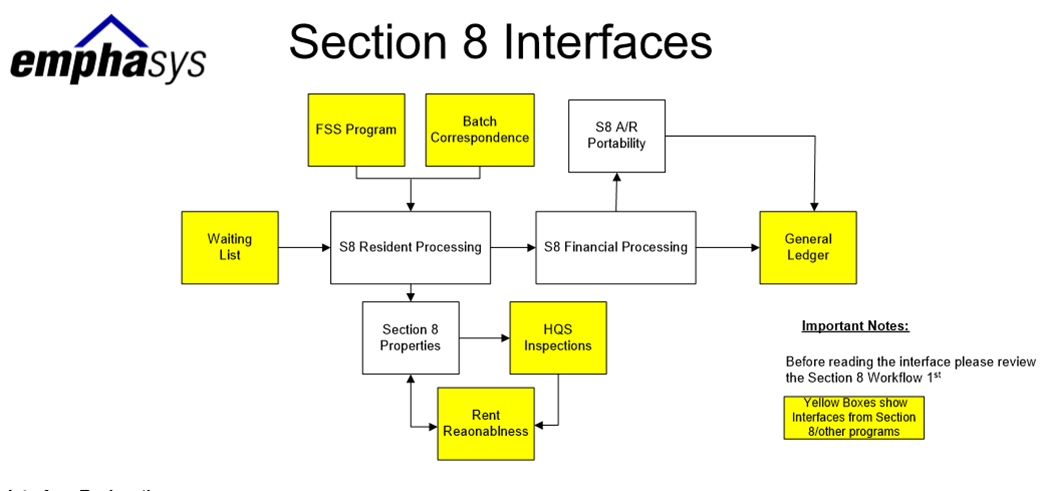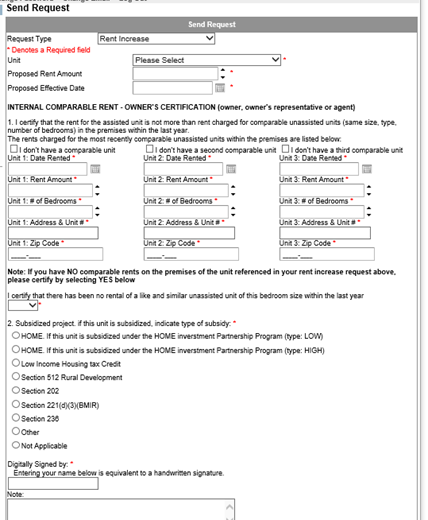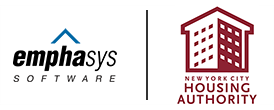 Betty is a current tenant living in a public housing unit that undergoes a RAD conversion. After the conversion, she completes her annual recertification and the PACT developer has conducted a contract rent change.
Betty is a current tenant living in a public housing unit that undergoes a RAD conversion. After the conversion, she completes her annual recertification and the PACT developer has conducted a contract rent change.
Use case: The system should allow for migration of case data from Section 9 to Section 8.
How it works:

Section 8 Occupancy Workflow – In the voucher offers, the applicant is provided an offer letter with a date to attend the briefing. Once the applicant attends the briefing then they will show up in the RFTA process, this will track the shopping days and allow the HA staff to receive the RFTA for the inspection process. In the RFTA process, the system will ensure that there is no 40% violation. After the RFTA is approved, the system will then allow the person to be leased up and moved in, with the ability to print a lease contract. When the move in process is completed, the system will generate an automatic new admission certification with the PIC Validation. Afterwards, the certification will be completed and waits in the resident file within the S8 resident processing for review and submission to PIC.
S8 Resident Processing – This is where you perform all your certifications, unless they are automatically created (e.g. the new admissions explained above). All past certifications and family changes are stored here for easy retrieval.
S8 Financial Processing – After the resident is moved into the unit, an adjustment, if appropriate (i.e. move in at the middle of the month), will be generated and stored in the resident file for review. In the S8 Financial, you will have the ability to process checks, create manual adjustments, perform exclusions/abatements.
S8 Properties – The property information is typically gathered in the RFTA process, but can be put directly into the system. Within the property file, the system will track all residents that have been previously housed and, if the inspections module is not purchased, the system will allow the user to complete the inspection results for the 50058.

Historical snapshots are kept within the system for easy retrieval. The data is stored in our SQL database which is encrypted in transit. Elite is SOC 2 compliant.
Data Conversion
Data conversion is the single most critical element of any system implementation. We understand that data left in a legacy system creates an IT maintenance burden as well as end-user loss of reporting. Emphasys dedicates a team of professionals and significant investment to ensure a successful data migration. Resources include systems analysts, conversion engineers, testers, and implementation consultants.
Data Conversion Team
Emphasys has assembled a highly skilled, dedicated team to handle NYCHA data conversion. Specialties on this team include data analysis, working with SSIS (Microsoft SQL Server Integration Services) to automate the conversion process, and possessing a complete understanding of the data from over 40 years of experience and exposure to other housing software. The majority of our conversion team has worked for Emphasys in the Implementation and Support area, where they have developed an immense and thorough knowledge of our clients’ needs.
Data Conversion Approach
The data conversion approach begins with the Kickoff Meeting, where the Emphasys Project Manager and NYCHA will set the goals and plan for the conversion, training and implementation processes.

Emphasys provides continuous support to NYCHA through the conversion process as outlined in the conversion process detail below.
The Conversion Process
There are four critical tasks for all conversions, which include data extraction, data mapping, conversion and verification, each of which are discussed in further detail below.
- Data Extraction
NYCHA provides their extracted data in a flat ASCII format per specifications provided by Emphasys. Emphasys and NYCHA will assess the condition and completeness of historical data. Both parties will review the historical data that will be converted and how compatible it is with Elite. Elite is an enterprise-wide integrated solution and performs operations on historical data. For example, Elite will automatically re-determine rent based on retroactive certifications and historical financial activity. If the historical information is incomplete or inaccurate, Elite will still attempt to make historical adjustments. If the historical conversion data is inaccurate, Elite’s adjustments will inherit that. If the data is incomplete, Elite may not make the adjustments at all. Emphasys may have to pre-populate required fields in Elite that do not exist in NYCHA’s legacy systems. If key, critical information is missing, the fabricated data may not work to NYCHA’s expectations. Emphasys and NYCHA will work together to arrive at a solution that will work long-term.
Emphasys is fully capable of converting historical data. However, the general recommendation is to limit the historical data that is converted. Data systems are very different and certain required fields may not be available or not all fields accurately crosswalk between the systems. Emphasys recommends writing the historical data to file for reference purposes and starting the new system with balance forwards or baseline information. Additionally, the Legacy Software can typically be kept online for historical and lookup purposes. We find this approach to be in the best interest of the client so as to insure the integrity of the source data in its original format. Emphasys would like to have further discussions with NYCHA to come to a mutual agreement on data conversion items.
- Data Mapping
Emphasys has developed mapping templates that have been used for many years to convert data from many agencies. The extracted data will be mapped to the mapping templates and used to create load programs into Emphasys’ data conversion load format. Our standard mapping templates and conversion programs capture the majority of the information that is required by NYCHA. Emphasys will convert all current operational data that can be converted from NYCHA legacy systems. The exact amount of data converted depends on NYCHA assessment of the quality and cleanliness of the data.
- Data Conversion
Conversion tasks take place throughout the implementation process. Data conversion programming will go through, at minimum, three conversions: initial iteration, core process review iteration, and final go-live conversion. Data is converted several times to ensure its accuracy prior to go-live. NYCHA will have usable data for the core process review and training.
Each time a conversion is done, Emphasys consultants and the NYCHA implementation team will review the converted data in a special conversion environment and document issues. Emphasys will also prepare testing and training environments which contain the most current conversion iteration as well. Every conversion gets closer and closer to the ideal, acceptable end result. Emphasys and NYCHA will know when the conversion is ready when all programming issues from the conversion have been resolved. The documented issues fall into two categories: clean-up and programming items. All of the programming items will be returned to the conversion developers to modify the programming.
All of the clean-up issues will be addressed as part of the consulting services. There are different types of clean-up: before conversion, during conversion, after go-live. In many cases, Emphasys can assist in the cleanup effort through the addition of clean-up scripts to the conversion. Emphasys provides continuous support to NYCHA through the conversion process.
Emphasys has converted data from every major PHA software system many times. Emphasys converts the following information as part of a standard conversion:
- All Applicants and Waiting List(s)
- All Applicant Eligibility Information
- Housing Choice Voucher Residents (All Active, Selective Inactive)
- Accounts Receivable – All Open Balances (Charge/Credit)
- Repayment Agreements
- Recurring AR
- Effective 50058 & Future 50058 Certifications
- Family & Supporting 50058 Data
- Other Relevant Resident Information
- Unit Information and Utilities
- Unit Payee and Owner Information
- Payee and Owner Payment Information
- Abatement/Hold Information
- Historical Data – to be mutually determined
- HQS Inspections
- Open and Historical Inspections – to be mutually determined
- Accounts Payable Payments including 1099 Balance – History to be mutually determined
- Family Self-Sufficiency
- Open and Historical Contracts – to be mutually determined
- FSS Participant Information
- Open Escrow Balances
- Public Housing Residents (All Active, Selective Inactive)
- Accounts Receivable – All Open Balances (Charge/Credit)
- Repayment Agreements
- Recurring AR
- Effective 50058 & Future 50058 Certifications
- Family & Supporting 50058 Data
- Other Relevant Resident Information
- Property Management Units
- Current Vacancy Data
- Historical Data – to be mutually determined
- Open Work Orders
- Historical Work Order Data – to be mutually determined
- Accounts Payable Vendors with 1099 History
- General Ledger – Current Fiscal Balances
- Prior Fiscal Balances – to be mutually determined
- Budget
NYCHA will be able to retain its known identifiers, such as client number, Section 8 contract number, vendor number, purchase order number, public Housing unit number, etc.
Emphasys will provide detailed conversion maps from previous housing authority conversions upon request. They are very detailed data conversion roadmaps that we use for converting data for hundreds of PHAs implementing our software.
Benefits to Emphasys’ approach to data conversion include:
- No parallel processing – Emphasys tightly coordinates training to coincide with a final data conversion deadline. A final data conversion is performed just prior to go-live.
- A minimal number of NYCHA resources – Key NYCHA staff will be involved with data conversion – specifically those staff who can help with data extraction, verification, and validation.
- Accurate, clean data
Emphasys appreciates the cost incurred by NYCHA to collect and maintain its data and is dedicated to converting the data from the existing system(s) consistently, timely, and efficiently.
Data Conversion Verification
During the verification stage of the conversion process, the Implementation Consultants, Conversion team, and NYCHA work closely to ensure that the data will function according to the business processes and software configuration that was determined by NYCHA and the implementation consultants during the Discovery and Workflow analysis phases. Emphasys will require NYCHA to participate in the verification process. This builds confidence in the data conversion and the knowledge of the system.
The verification process consists of record validation, report validation, screen display validation, and major process validation. For example, if the original tenant table held 2,000 records, then the destination table in Elite should have 2,000 tenant records. Any differences in record counts, will be accounted for using exception reports, along with missing data elements that are required by Elite. We strive for zero exceptions, but sometimes the original data is not correct and should be removed from the conversion or it must be cleaned-up prior to conversion.
Each conversion consists of multiple iterations, which are explained in more detail below:
First Iteration
- Authority provides Emphasys data in flat ASCII format per file definitions
- Emphasys codes conversion
- Emphasys provides the Authority with clean-up issues
- Emphasys performs preliminary verification
Second Iteration
- Emphasys provides converted data to the Authority
- Emphasys revises conversion code based on issues raised during verification
- Emphasys provides verification training to the Authority
- Emphasys provides verification reports to the Authority
- Authority provides Emphasys verification issues
Third Iteration
- Emphasys revises conversion code based on issues raised during verification
- Authority provides Emphasys refreshed data
- Emphasys reruns conversion and provides the Authority with refreshed data
- Authority provides Emphasys verification issues
Fourth Iteration – Go-Live
- Emphasys revises conversion code
- Authority/Emphasys develops contingency plan for cut-over
- Authority provides Emphasys refreshed data
- Emphasys runs final conversion
- Authority completes final verification
- Authority provides Emphasys sign-off
- Emphasys moves converted data from test to production environment
For each module requiring data conversion, the following tasks will be performed:
- Complete Technical requirement documentation
- Map legacy data to Emphasys Elite database and tables
- Develop data conversion test plan
- Build and test data conversion programs
- Deploy data conversion programs
- Perform final production data conversions
Use case: The system should allow for HQS inspections to take place by external parties and link the inspection to the correct case/unit (new Section 8 case and not old section 9 case).
How it works: We have an API to allow external parties to link to the inspections.
Use case: The system should include a workflow from RAD annual recertifications into the RAD Right Sizing process for RAD Voucher holders
How it works: The system will alert the user if the voucher holder, Betty, does not match the composition of the family and the bedroom size. This ensures that Right Sizing is being followed.
Use case: The system should allow for owners to request contract rent changes to a building and have it carry over to all units in the building.
How it works: The Landlord Portal allows owners to submit updated information as shown below. It will allow the rent change to go through the system for approval. However, with RAD units, once the rent change comes through, the system will ensure that the rent is increased no more than what is required by the 3- or 5-year plan the agency is on. If a tenant’s monthly rent increases by more than the greater of 10% or $25, the rent increase will be denied.

When the submission of the rent increase is complete, a caseworker will approve it. The system then creates a rent increase certification.
Use case: The system should allow for processing different methods of HAP calculations including for rent increase during contract rent change.
How it works: Resident Processing – Housing Choice Voucher – RAD – Project Based Vouchers (PBV)
- Elite will continue to determine Tenant Rent and HAP subsidy based on HCV program guidelines.
- Elite will, in coordination with the RAD PBV module, determine and track the rent phase-in, if required (If a tenant’s monthly rent increases by more than the greater of 10% or $25 purely as a result of conversion, Flat Rents, the increase will be phased in over 3 or 5 years).
- Elite will make the exception of RAD PBV conversion families that have EID, but would not qualify for EID under HCV until the EID ends (grandfather clause).
- Elite will continue to create HUD 50058s per IMS/PIC guidelines.
- Elite will continue to generate HAP/UAP payments per HCV program guidelines.
- Elite will integrate the HAP/UAP with the RAD PBV module (payment to receipt).
